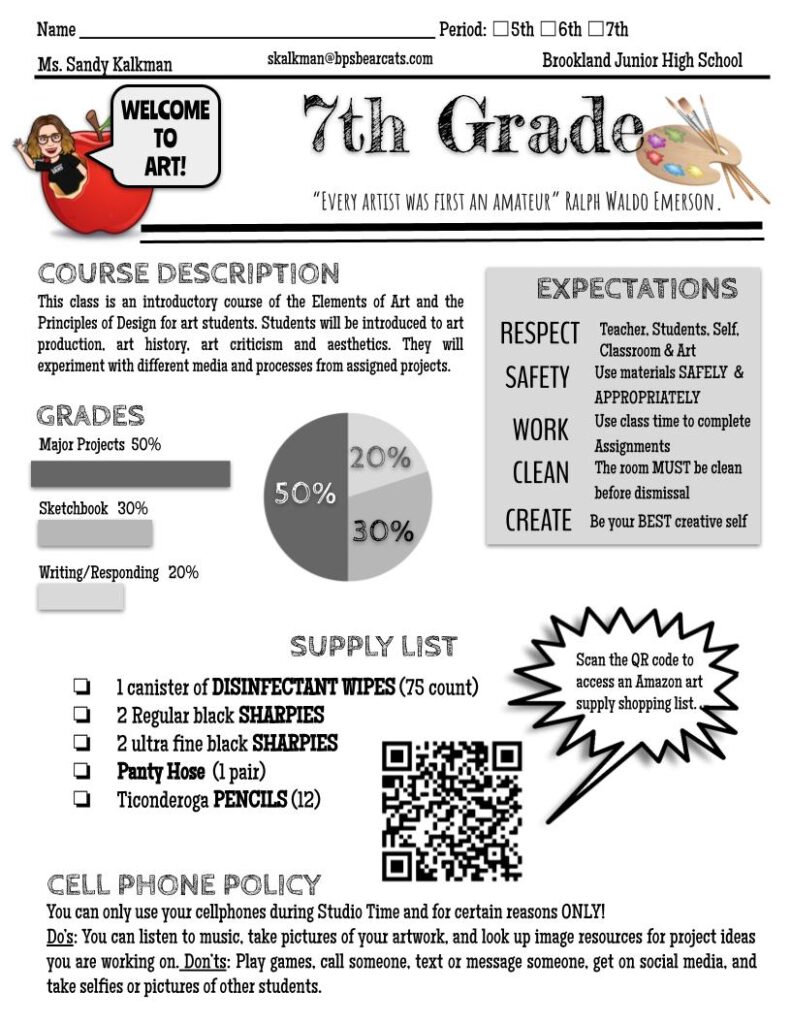Nothing says the start of the year like creating- or updating- your class syllabus. At baseline, a class syllabus can be a pretty dry document. It typically includes your contact information, course information and summary, prerequisites, and core requisites, required materials, course objectives, assignment list, academic policies, and classroom policies. Before launching into your syllabi, be sure to find out what your specific school and department might require on a syllabus.
What are some important things to think about with your syllabus for an art class? Think about what materials you want the students to provide. I generally asked students to purchase sketchbooks, erasers, and pencils. I would show examples in class and tell them the best places to find these items and include an approximate price. I love the below example that is linked with a QR code a recommended Amazon shopping list! I strongly recommend a statement on originality. In today’s copy-and-paste world, what constitutes original work needs discussion and a written policy. Do yourself a favor and make sure you see the development of a piece of artwork as part of the classroom expectation. Include your student cell phone policy in your syllabus and make sure it aligns with the school’s policies.

You definitely want to include information on grading policies. Take care to think through if you are going to state the weighting of categories. If, for example, sketchbook work is to be 1/3 of the final grade make sure that you have plenty of occasions to use and grade sketchbooks. If studio care and behavior are going to be a category make sure you can document those student behaviors. Carefully consider your policy on turning in work late as you will have to live and die by your words for the rest of the year.
By their nature, course syllabi are rather dry documents. There are ways to liven them up though. Art teacher Mallorey Garrett changed hers to be doodle syllabuses for all her art classes.

In a similar vein, art teacher Ashley Mills was inspired to make a visual syllabus for her visual classes.

Interject a little bit of you into the design with a bitmoji like Danielle Helvie-Juárez.

Break out from the expected. Art Teacher Shona Pate creates a scavenger hunt using Flipgrid for her middle school art students. She films several tutorials on each area of the room and puts them on Flipgrid. She then downloads the QR codes and places them in different areas of her room. The kids get into pairs or by tables and grab an iPad or use their own phone if they have the app. They fill out a worksheet and the first group done receives a prize.
Art Teacher Marie Fitzpatrick went digital a few years back making it into a slide deck. In addition to the slide decks she writes, “What I wound up doing was I had the students make sketchbooks and I created a syllabus that they placed inside their sketchbook.” See her sketchbook versions below. Another teacher has her students paste them onto their portfolios for easy reference.

This brings me to a pet peeve I have since becoming a parent of middle/high school-age children. Parents are inundated with paperwork from schools during those first few school days. I found I was pressed to sign forms that I didn’t have the time to read. Eventually, I started taking photos of the documents so I could read them after the fact. A parent can’t possibly absorb all the information that is coming at them in a short amount of time. So, think about how you can make the information available to them in a way parents can return to. For example, send a copy by email or place it on your website.




